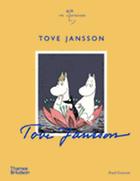
Paul Gravett's Tove Jansson, the potted biography of the author best known for the Moomins, showcases the development of her artistic style and literary themes. Born at the start of World War I into a family of artists (her father was a sculptor; her mother, a graphic designer; her brother, Lars, a collaborator on her comics), Jansson wanted to paint but had limited opportunities as a woman. After art college, she undertook commissions and freelance work. The first Moomins book was published in 1945; the second, Comet in Moominland, arose from the fear inspired by air raids. She landed her first permanent salaried job at age 37, a daily comic strip for Associated Newspapers.
Tove Jansson contains a wealth of illustrations--more than 100, so nearly one per page--as well as photographs and high-quality reproductions, many in color and some in black and white, of Jansson's comics, paintings and book covers. Later in the Moomins series, she adopted line drawings in thick layers of pen, achieving a "rich range of shading." Gravett (Mangasia; Comics Art) also probes the autobiographical influences on Jansson's work, which are particularly clear in her 15 books for adults. She lived with her female partner, Tuulikki Pietilä, for 45 years but, because homosexuality was illegal in Finland until 1971, had to be covert about relationships with women. She inserted anti-Nazi sentiments into her cartoons and her work is often melancholic, a response to bereavements.
A sensitive portrayal of Finland's most widely translated author, this itself is a work of art. --Rebecca Foster, freelance reviewer, proofreader and blogger at Bookish Beck

